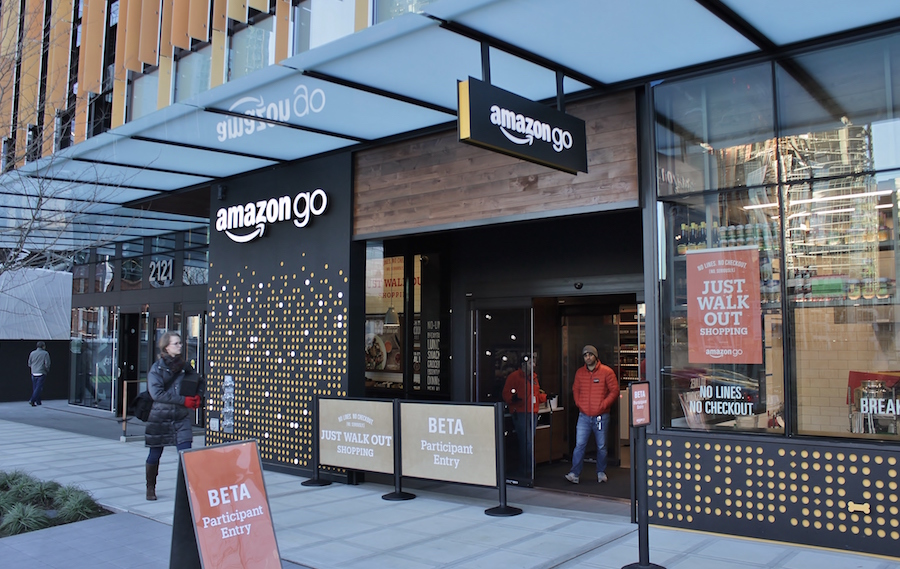Digimarc wades into a hyper-competitive retail market to save in-person shopping.
From his conference room in a Beaverton office park, Digimarc CEO Bruce Davis is far removed from the tech startups multiplying below in Portland. He’s eager to counter their techno-optimism with the steady, almost grandfatherly advice of an industry veteran.
“When something new happens it looks like it’s taking over the world, but it never does,” the 66-year-old Davis says. “It swings back and forth, and you find the balance.”
Davis rode that technology pendulum from analog devices to virtual reality and back again. He moved from developing TV guides in the early days of the Internet to the top job at video game giant Activision to invisible barcodes at Digimarc.
Amid fears of overbuilt retail and the stratospheric rise of e-commerce, Davis is betting that customers will still walk into stores. The future of retail, he says, hinges not on a battle between e-commerce and brick-and-mortar, but an “omnichannel” approach that makes use of both.
It’s been about four years since Digimarc made a crucial pirouette from security to retail and consumer products. Now the company is finding its footing in the intensely competitive market, as investors grow anxious for a payoff.
 This Amazon Go store in Seattle does away with store clerks entirely. Wikimedia Commons / SounderBruce
This Amazon Go store in Seattle does away with store clerks entirely. Wikimedia Commons / SounderBruce
For several years, experts have prophesied the demise of brick-and-mortar retail with dire warnings of a “meltdown” and “apocalypse.” In 2017 J.C. Penney, RadioShack, Macy’s, and Sears each announced more than 100 store closures. Sports Authority liquidated, and Payless filed for bankruptcy. Forecasters pinned the casualties on Amazon, overbuilt malls and Americans channeling disposable income toward food instead of clothing.
This trajectory will likely continue through 2018 and beyond. Speaking at an urban planning conference in Portland last spring, Rick Stein, founder of consulting firm Urban Decision Group, estimated retail is overbuilt by 50%.
The threat of e-commerce is real.
Sportswear retail analyst Matt Powell of NPD Group estimates than in just a few years, the share of athletic shoes sold online could reach 50%. Younger consumers who prefer to buy online are replacing ageing boomers. Every company sees growth in the direct-to-consumer market, Powell says, which largely centers around an online shopping experience.
“When something new happens it looks like it’s taking over the world, but it never does,” Davis says. “It swings back and forth, and you find the balance.”
Yet as the economy adds to consumers’ paychecks, in-store retail is expected to grow along with online. Deloitte advises in its 2018 retail outlook that, “maintaining a dual in-store and online presence will remain increasingly important.”
Davis, for one, doesn’t fear e-commerce.
“Amazon is almost 25 years old, and they only have a few percent of retail,” he says. “How many years do you want to give them before they take over the world?”
Founded in 1995, Digimarc has only turned a profit in two of its twenty years with Davis at the helm. He has pursued a unique strategy, taking losses for up to a decade while making acquisitions and investments in promising technology.
Then comes a payoff. Davis says he’s generated $600 to $700 million for shareholders throughout his tenure. In 2008 the conclusion of “phase one” of Davis’ strategy, the company paid out $310 million to shareholders.
“It’s very unusual to be in the public market with that kind of profile,” Davis says of his strategic focus on decades-long investment instead of quarterly profits. “But it’s who I am, and everyone understands it.”
 A checkout line at Target. Courtesy Nate Grigg
A checkout line at Target. Courtesy Nate Grigg
The company built the foundation of its business on anti-counterfeiting technologies for the Central Banks and other institutions.
Later, in 2014, Davis began a push toward retail and consumer products contracts. In the ensuing four years, the company landed major contracts with big box retailers, including Walmart and mid-size grocery chains like Wegmans and New Seasons.
The technology revolves around the barcode. Digimarc bakes its mark into the color of a product. The signal runs deeper than the symbols on a box of cereal or even the ink. It’s embedded in the text file that instructs a computer how to make blue look like blue. That makes it completely invisible.
“Amazon is almost 25 years old, and they only have a few percent of retail,” he says. “How many years do you want to give them before they take over the world?”
The Digimarc barcode is the cornerstone of the impending omnichannel retail structure, Davis says. Customers in a clothing store, for example, could scan a shirt to find their desired size and color in the store’s entire inventory. Then they can get the right shirt any way they choose: there in store, by mail or by pickup later.
The barcode can also speed up checkout for grocery stores. According to a study commissioned by Digimarc, 39% of shoppers say they’ve left a store empty handed to avoid the lines.
New Seasons began testing the Digimarc barcode in 2016, says Chris Tjersland, director of brand development, and it has shortened checkout time. Customers can also scan the chain’s Partner Brand private label products to learn about the producers.
“We are still testing the checkout process at a targeted selection of stores in Oregon, Washington and California,” Tjersland writes in an email, “but see incredible potential with future capabilities.”
 A New Seasons store in Woodstock. Wikimedia Commons
A New Seasons store in Woodstock. Wikimedia Commons
Digimarc’s financial growth hinges on that potential.
Not everything is going according to plan. Five customers accounted for 78% of Digimarc’s revenue in 2017 — 55% came from the Central Banks alone — and the company needs to diversify to expand.
Even as contracts with retailers fall into place, sales growth is stagnating.
Digimarc sales reps struggle to win over the big box stores amid an array of competitors, including traditional barcodes, QR codes and similar data-carrying codes embedded in ultraviolet or infrared-responsive inks. Unlike these methods, the Digimarc barcode requires no special inks or materials — just a few lines of computer code.
The company took net losses in the past few years to invest in product development and sales growth, according to SEC filings. Operating expenses increased by $8 million, or 23% between 2016 and 2017, reflecting investments in sales, marketing and engineering. Net losses steadily increased since the 2014 shift. In 2017, the company lost $25.7 million on $25.2 million in revenue.
“When you’re not making money you need to be growing. That’s the challenge for us right now,” Davis says. “I think about it every second of the day. And night.”
To satisfy investors, Davis says, he needs to make sales to the major chains, which will convince smaller retailers to follow. To that end, he’s been making changes with goal of increasing productivity at the same level of investment. He brought senior IBM salesmen on board and reorganized some other roles in the company.
“When you’re not making money you need to be growing. That’s the challenge for us right now,” Davis says. “I think about it every second of the day. And night.”
He’s hopeful about consumer trends, despite the challenges underway. Shoppers have grown wary of technology’s rapid advance. They seek a return to the friendly neighbor store clerk, the face-to-face conversations, the paper book. Not keen on social media, Davis worries about a future where, “everyone’s just a blob; they weigh 450 pounds; they live in a dark room with a screen. That’s Facebook’s dream I guess.”
Digimarc’s technology, he says with a bit of a flourish, will help counter technological dependence.
“It’s hopefully my greatest work, my greatest contribution to society, to give this a go. It will make everybody return to humanity a bit.”
To subscribe to Oregon Business, click here.





